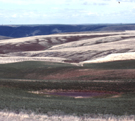The Role of Solar Activity on Holocene Glacier Length Variability in the Swiss Alps
Hormes, A., Beer, J. and Schlüchter, C., 2006. A geochronological approach to understanding the role of solar activity on Holocene glacier length variability in the Swiss Alps. Geogr. Ann., 88 A (4): 281–294.
Review by George Taylor
A team of European researchers has found that glaciers in the Swiss Alps have lengthened and receded repeatedly during the Holocene in significant correlation with changes in solar irradiance.
Anne Hormes of Ångströmlaboratory, Uppsala University, Sweden, Jürg Beer of the Department of Surface Waters, EAWAG, Dübendorf, Switzerland, and Christian Schlüchter of the Department of Quaternary and Environmental Geology, University of Bern, Bern, Switzerland were the researchers.
Abstract — We present a radiocarbon data set of 71 samples of wood and peat material that melted out or sheared out from underneath eight present day mid-latitude glaciers in the Central Swiss Alps. Results indicated that in the past several glaciers have been repeatedly less extensive than they were in the 1990s. The periods when glaciers had a smaller volume and shorter length persisted between 320 and 2500 years. This data set provides greater insight into glacier variability than previously possible, especially for the early and middle Holocene. The radiocarbon-dated periods defined with less extensive glaciers coincide with periods of reduced radioproduction, pointing to a connection between solar activity and glacier melting processes. Measured long-term series of glacier length variations show significant correlation with the total solar irradiance. Incoming solar irradiance and changing albedo can account for a direct forcing of the glacier mass balances. Long-term investigations of atmospheric processes that are in interaction with changing solar activity are needed in order to understand the feedback mechanisms with glacier mass balances.
The researchers radiocarbon dated bits of wood and peat material that emerged from underneath eight present day mid-latitude glaciers in the Central Swiss Alps. The organic matter had grown in the glacial basins when the glaciers were smaller:
more »
